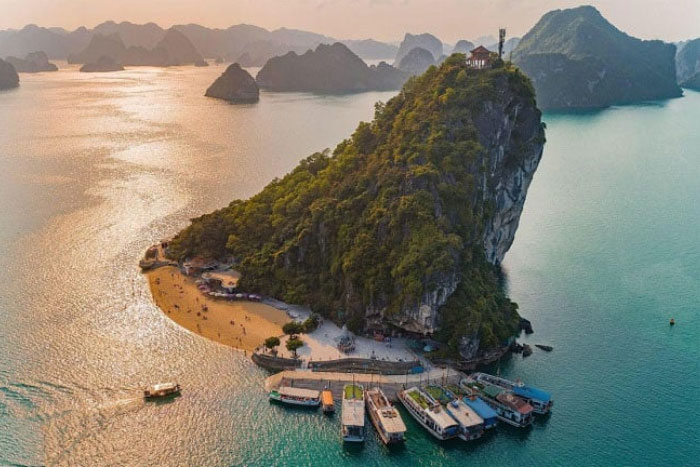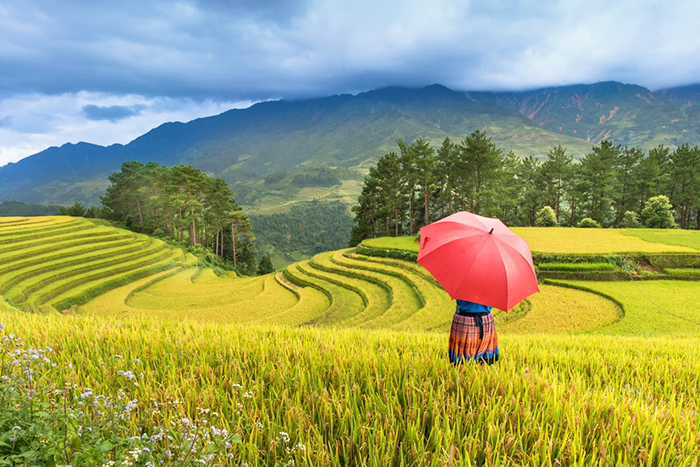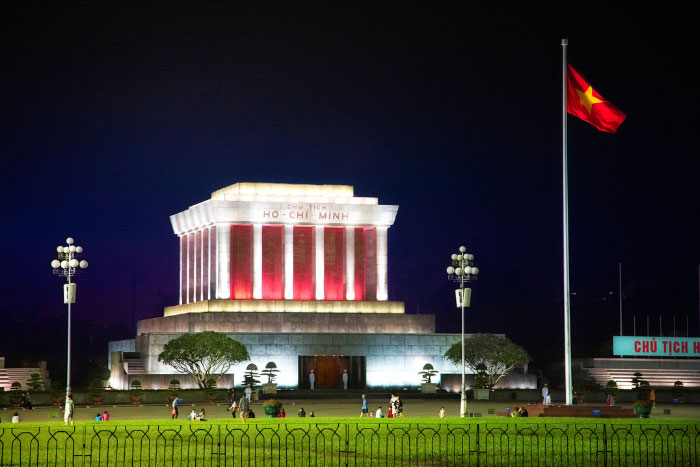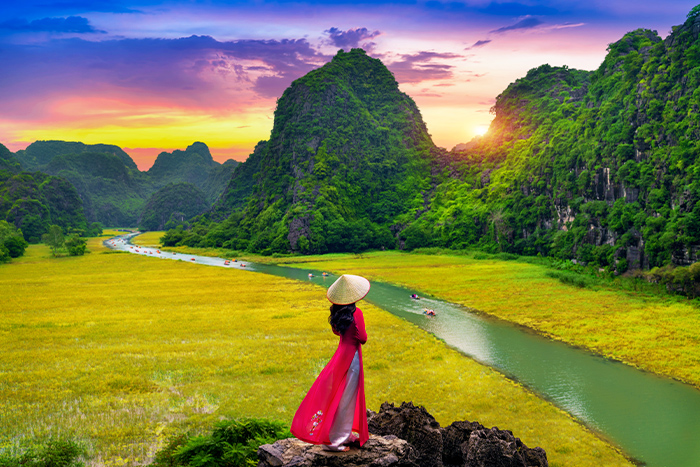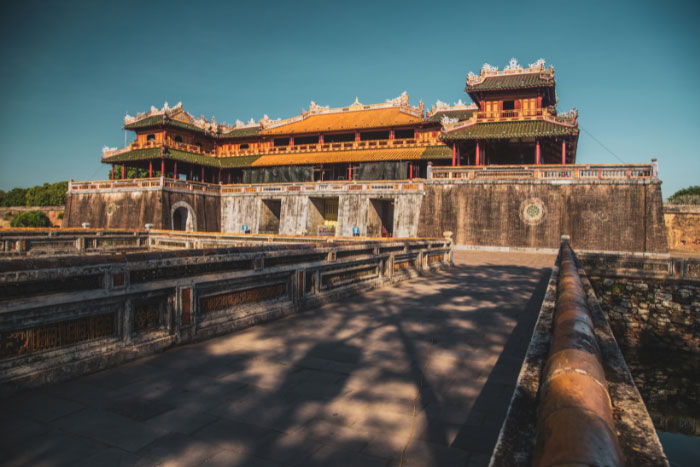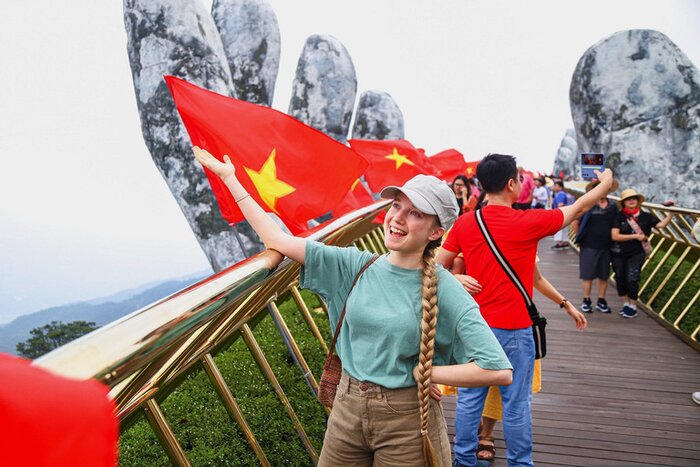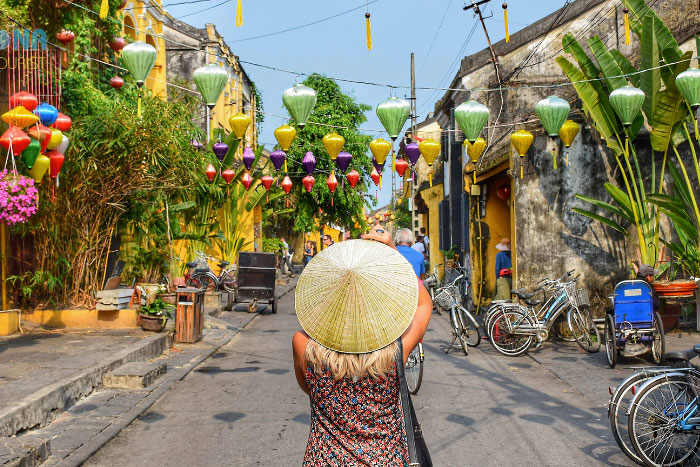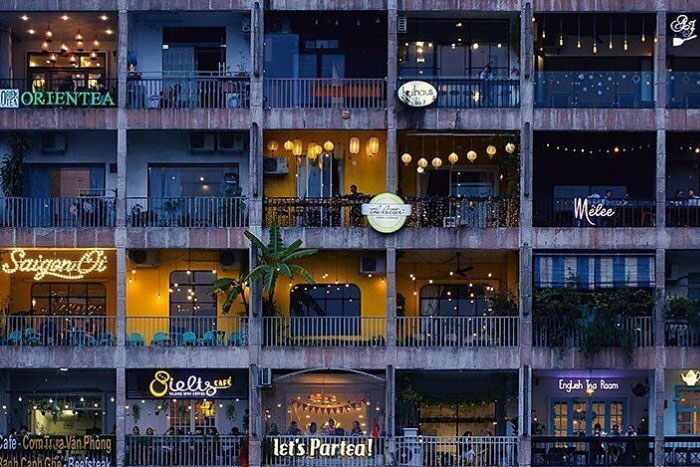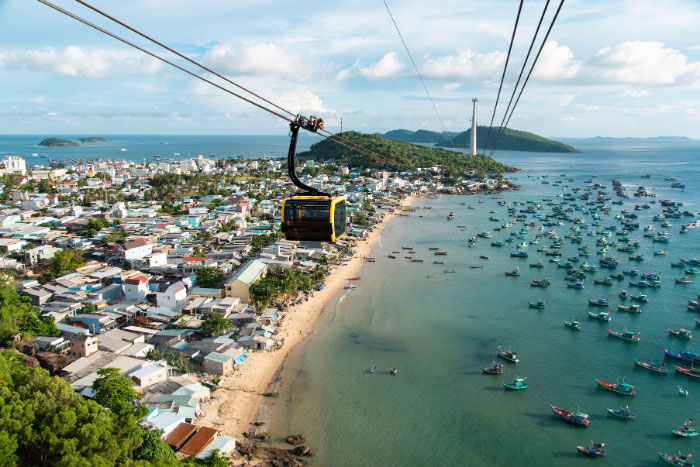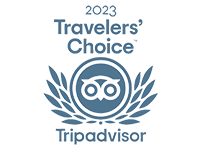What Is The Most Visited Place In Vietnam? Vietnam is a country of diverse landscapes, rich history, and vibrant culture, offering travelers a range of experiences that cater to different interests. From bustling cities and historic sites to stunning natural wonders and serene countryside, Vietnam’s most visited places provide a captivating journey through this dynamic Southeast Asian nation. Here are some of the key themes and Vietnam most visited places.
1. How did Vietnam become famous for tourists?
It is only since the late years of the 20th century that Vietnam has really begun to establish itself as a tourist country and open its doors to the outside world. Bringing along rich history, high cultural value, and great natural beauty, Vietnam became one more desirable location for travelers who prefer more authentic, less commercial, and extremely affordable holidays. Its charm continued to increase with the surprising discovery of ancient cities, beautiful beaches, and busy street life; it truly has become one of the must-see places across Southeast Asia today.
The role of media in general was very significant, particularly through travel vlogs and programs on TV. Travel vloggers began to share their experiences in Vietnam through YouTube, showcasing the country's special features, street food, and many other hidden things to the world. These vlogs gave users a first-hand view of Vietnamese culture and landscapes, hence making it closer and more alluring to the new generation of travelers.

Probably the most serious impetus to Vietnam's tourism boom was a visit by
Anthony Bourdain, the famous chef and travel documentarian. In his shows, particularly "Anthony Bourdain: No Reservations" and "Parts Unknown," he showcased the rich culinary traditions and vibrant culture of
Vietnam most visited places. Bourdain's deep appreciation for Vietnamese food—more so on the streets, pho and bun cha—are what a lot of viewers were introduced to in this country's culinary delights. His personable portrayal of Vietnam not only drew food lovers but also gave many a reason to travel there for real experiences, thereby sealing Vietnam's position as one of the greatest places to be visited in the world. So
What Is The Most Visited Place In Vietnam?2. Most visited places in Vietnam
a. Halong Bay
To the north of
Vietnam most visited places, in South East Asia, lies
Halong Bay, one of the country's most natural wonders and classed as a UNESCO World Heritage site. The bay is characterized by extremely interesting geographical features: more than 1,600 limestone islands and islets that rise up, dramatically, against the emerald-green waters of the Gulf of Tonkin. These karst formations span millions of years of geological construction and come together to form a real visual symphony that captivates nearly every traveler to these parts of the world. Most of its islands are uninhabited and take on fantastic shapes, which usually relate to local legends and folklore. Hidden caves or isolated beaches and perhaps floating fishing villages - all that can be discovered by a boat exploration of this bay - an unforgettable trip in the wilderness of Vietnam.
On the other hand, existing with the breathtaking landscapes, Halong Bay is also extremely rich in the field of biodiversity, containing countless marine areas, coral reefs, and dense tropical forests. The ability to view it up close also pulls in tourists who are able to enjoy kayaking, swimming, and scuba diving. Visiting Halong Bay is one of those places that is a favorite spot for every person seeking equal proportions of adventure and relaxation. It has beautiful calm waters and scenic beauty. Halong Bay is quite a spectacular place to be—from the deck of a traditional junk boat to closer views.
b. Sapa
Situated in the mountain area of northern Vietnam,
Sapa is a beautiful town famous for its gorgeous, staircases-like rice fields, mist-covered valleys, and rich cultural diversity. Located in the Hoang Lien Son mountain range, Sapa commands a head-view of surrounding peaks, including Fansipan, the highest mountain of Vietnam. This region is famous for its tiered rice paddies, which go down the hills and change colors as per the time of the year. It turns out to be a place where photographers and nature-lovers will feel at home. Sapa's cool climate, along with great scenery, has made it a favorite haunt of trekkers who go along verdant trails, past waterfalls, and ethnic minority villages.
Cultural wealth is another vital attraction that Sapa offers. The town is inhabited by several ethnic minority groups—the Hmong, Dao, and Tay—who have maintained their traditional ways of life, dresses, and customs. Visitors can experience the local markets, offering brightly colored textiles and handmade crafts, and join a homestay in the villages to have first hand exposure to the lives and traditions of these people. With strong natural beauty and a rich cultural heritage, Sapa is one of the places anybody visiting Vietnam most visited places must see.
c. Hanoi
Hanoi is the capital city of Vietnam, and it resounds with history, culture, and charisma in this beguiling mix of old and new. Its historic Old Quarter is a maze of narrow streets lined with centuries-old architecture, bustling markets, and traditional shops. The street life here is extraordinarily lively, with vendors touting everything from fresh produce to hand-hewn goods, and with the smell of Vietnamese street food wafting through the air.
What to do in Hanoi? With
historical places, such as the Mausoleum of Ho Chi Minh, remains of the Temple of Literature, and the serene Hoan Kiem Lake, where one can sequester oneself from the mad bustle of the city.
Beyond the inimitable historic charm, Hanoi is also a city abounding in cultural vibrancy and modern energy. The city is also home to many galleries, museums, and theaters that showcase Vietnamese traditional and contemporary art and performance. The food scene in Hanoi is equally charming, with its varied dishes proving just why such a great reputation has been built for it, from the famous pho to flavorful bun cha. What it represents—something between tradition and modernity—and warm hospitality make Hanoi very attractive to travelers who want to explore Vietnam most visited places in all its forms.
d. Ninh Binh
Situated in the northern part of Vietnam,
Ninh Binh is sometimes referred to as the "Ha Long Bay on land" and features dramatic landscapes with abundant cultural heritage. Such karst features are typically defined by towering limestone karsts arising from lush rice paddies and serpentine rivers that supply plenty of natural beauty, serene and majestic alike. One of the most popular ways to experience Ninh Binh is by boat, floating along the Ngo Dong River through Tam Coc-Bich Dong, which represents caves, temples, and green fields, offering a tranquil and pictorial time. Trang An Scenic Landscape Complex, one of the UNESCO heritage sites, goes on to demonstrate the beauty with a network of limestone mountains, valleys, and sacred sites.
Besides natural beauty, Ninh Binh is imbued with history and culture. In the province can be found the ancient capital of Hoa Lu, which was the political and cultural center of Vietnam during the 10th and 11th centuries. Visitors have an opportunity to get familiar with remains of this ancient capital, such as ancient temples or the royal palace, to give an idea about Vietnam in old times. This region is home to the Bai Dinh Pagoda, which is also one of the largest Buddhist complexes in Southeast Asia. Moreover, it attracts lots of pilgrims and tourists. Beautiful landscapes, historical value, and rich culture make Ninh Binh a perfect destination for all those visiting Vietnam most visited places in search of a different experience.
e. Son Doong cave
Located next to
Phong Nha-Ke Bang National Park in central Vietnam,
Son Doong Cave is the world's largest cave and, without a doubt, one of the most amazing natural wonders on Earth. Having been discovered as recently as 2009, this is a really huge cave: it is more than 5 kilometers long, and in places, it has a height of 200 meters and a width of 150 meters, large enough to hold city blocks. There is a wealth of fantastic underground landscapes—from the towering stalagmites to enormous chambers, even its own rainforest with unique ecosystems. Its sheer size and unearthly beauty have already earned the cave a place on the to-do list of adventurers and nature lovers from all over the world.
The Son Doong Cave actually offers lifetime exploration experiences—journeys into untouched underground worlds. It's a hard trek to get to the cave, and one has to hike for days through dense jungles and cross rivers, but the reward is an unparalleled exploration of a hidden natural marvel. Visitors will see formations few have ever seen, swim in underground rivers, and witness the "Hand of Dog," one of the largest stalagmites in the world. Accordingly, the sense of discovery and awe that accompanies the exploration of Son Doong has made it one of the top destinations for people in search of adventure and a connection with one of Earth's most pristine environments.
f. Hue
Hue is a historic city full of culture that is centrally located in Vietnam. It is recalled to be the former imperial capital of the Nguyen Dynasty. The city is most famous for its grand complex of historic sites, like the Imperial City, which has been declared a UNESCO Heritage Site. On its own, the Imperial City—thronged with ancient palaces, temples, and pavilions—provides a very interesting glimpse into the past of Vietnamese royalty. Walking through the citadel one can view the intricate architecture, calm gardens, and royal tombs that open to the scenes of greatness and sophistication of Nguyen emperors. The Perfume River running through the heart of the city enhances further beauty to Hue with its many scenic boat rides; the visitor views historical landmarks along the river and also sees the countryside with its lush green surroundings.
Apart from being soaked in history, Hue is considered a center for Vietnamese culture and cuisine. The city is well-known for its traditional music, poetries, and festivals that add color to the rich heritage of Central Vietnam. Hue gastronomy is not second to any. It is remembered to be a place for delicate and intricate dishes which once served in the royal court. Specialties like bun bo Hue, spicy beef noodle soup, and other food options like steamed rice cakes, should not be missed by foodies. For living through the centuries, Hue offers something that no other place does to travelers on a quest for experiencing at its best a taste of imperial Vietnam most visited places with: historical depth, cultural richness, and gastronomic excellence.
g. Da Nang
Located on the Central Coast of Vietnam,
Danang is a vibrant city with modern amenities, beautiful beaches, and rich cultural attractions. It is one of the major port cities in the country, offering a perfect blend of urbanity and natural beauty. The city is also graced with a fine coastline that includes
My Khe Beach and Non Nuoc Beach, featuring soft white sands and clear blue waters perfect for relaxation and water sports. Not leaving out a piece of natural wonder to enhance Da Nang's urban appeal, the Marble Mountains is a cluster of five limestone hills with caves and temples that give a good overview of the city and the surrounding landscape.
Besides beaches and mountains, Danang also serves as the access to many other relevant cultural and historical attractions. The place is near the ancient town of Hoi An, a UNESCO World Heritage site famous for well-preserved architectures and traditional crafts. Da Nang is also near the historic ruins of My Son—a chain of Hindu temples dating back to the Champa Kingdom. The iconic Dragon Bridge of the city, which breathes both fire and water during weekends, gives a rather modern touch and dynamism to its skyline. The combination of cultural attractions and natural beauty, as well as modern infrastructure, makes Da Nang very attractive to travelers who look for a mix of relaxation and exploration when visiting Vietnam most visited places.
h. Hoi An
Situated in the center of Vietnam,
Hoi An is a pretty town with ancient architecture remarkably well-preserved and rich culture mixed with a rustic touch. This ancient town in Hoi An is one of UNESCO's World Heritage Sites, marked by its two lanes of streets lighted with lanterns, lined on both sides with wooden traditional houses, ancient temples, and brilliantly colored colonial buildings. The setting is beguiling, bringing out a rich history of the town as one of the main trading ports from the 15th to the 19th century— Chinese, Japanese, and European traders combined their influences in this unique architectural style.
The town is also well-known for its bustling markets and artisan shops where visitors will find handmade crafts, textiles, and tailor-made clothing. The Hoi An Central Market is an entrepreneurial hub for fresh produce, street food, and local merchandise. Nevertheless, the town's food scene boasts its very own flavors, teased in dishes unique only to them, Cao Lau being a savory noodle dish while Banh Mi represents a Vietnamese sandwich. Food lovers around the world are sure to be in love with them. Hoi An is sure to capture your heart with its atmosphere, Cultural Heritage, and culinary delights, making the town a place to visit for an insight into the Vietnam most visited places.
i. Ho Chi Minh City
What to see in Ho Chi Minh City? Formerly known as Saigon, is the biggest city of Vietnam, located in the south, and represents a booming economic and cultural center. It blends a dynamic combination of historic landmarks, modern skyscrapers, and street life. Historic
Reunification Palace, marking the end of the Vietnam War, and the strikingly beautiful
Notre-Dame Cathedral Basilica of Saigon are the key examples of French colonial architectural heritage. There is the vivacious
market of Ben Thanh, wherein a visitor gets everything from handicrafts to street food.
Other than the historic and architectural attractions, Ho Chi Minh City is very famous for its night and food activities. Every night, the streets come alive with restaurants, bars, and street food vendors offering a variety of food choices—local Vietnamese to international cuisine. Places like
Bui Vien Street, specifically, are popular with a real night scene going on, boasting a number of bars and other kinds of entertainment. Ho Chi Minh City has a wealth of history, a modern feel, and good food, making it one of the top travel spots for travelers looking to experience the culture but who don't mind a bit of city action. Surely one of
Vietnam most visited places.k. Phu Quoc
Phu Quoc, Vietnam’s largest island, is renowned for its pristine beaches, clear turquoise waters, and lush tropical landscapes. Located in the Gulf of Thailand, off the coast of Cambodia, the island is a tropical paradise offering a range of activities from relaxation to adventure. Phu Quoc’s coastline is dotted with stunning beaches such as Long Beach and Sao Beach, where visitors can unwind on soft white sands and swim in the warm, crystal-clear sea. The island is also known for its vibrant coral reefs, making it a popular spot for snorkeling and diving.
Beyond its beautiful beaches, Phu Quoc is rich in natural beauty and cultural heritage. The island is home to dense rainforests and scenic landscapes, with the Phu Quoc National Park offering opportunities for hiking and wildlife spotting. Local markets, such as the Dinh Cau Night Market, provide a taste of the island’s fresh seafood and traditional cuisine. Additionally, Phu Quoc is famous for its production of fish sauce, a key ingredient in Vietnamese cuisine, and visitors can tour local factories to learn about this integral aspect of local culture. Phu Quoc’s combination of stunning natural beauty, cultural experiences, and relaxed island atmosphere makes it a popular destination for those seeking a serene getaway in Vietnam most visited places.
3. Some tips for your Vietnam visit
Here are some travel tips for visiting Vietnam most visited places:
- Be Prepared for the Climate: Vietnam's weather varies significantly from north to south, so pack accordingly. The north can be chilly in winter, while the south remains warm year-round. The rainy season typically occurs from May to October, especially in the central and southern regions.
- Learn Basic Vietnamese Phrases: While many people in tourist areas speak English, learning a few basic Vietnamese phrases can enhance your experience and help you connect with locals. Simple greetings, thank you ("Cảm ơn"), and polite phrases go a long way.
- Respect Local Customs: When visiting temples and religious sites, dress modestly by covering your shoulders and knees. Always remove your shoes before entering someone's home or a sacred space, and be mindful of local etiquette, such as avoiding public displays of affection.
- Bargain Smartly in Markets: Bargaining is common in Vietnamese markets, but do so respectfully. Start with a counteroffer of about half the initial price and negotiate from there. Keep the exchange friendly, and remember that a smile can go a long way.
- Try Street Food, But Be Cautious: Vietnam is famous for its street food, offering delicious and affordable meals. To avoid foodborne illnesses, choose stalls that are busy and have a high turnover of food. Stick to dishes that are cooked fresh, and be cautious with ice and raw vegetables.
What Is The Most Visited Place In Vietnam? There you have your answers. By following these instructions, you can easily have the best time of your life here in
Vietnam most visited places. We hope these informations are helpful for you in preparing for your trip to see the most scenic places in Vietnam. If you wish to have a wonderful holiday in Vietnam, don't hesitate to contact
Autour Asia - best travel agency in Vietnam. We invite you to experience the genuine beauty of the Vietnamese people and memorable moment during your travels.
Which Part Of Vietnam Is Most Scenic?
Which Part Of Vietnam Is Most Scenic? The northern region of Vietnam is often considered the most scenic part of the country, offering a diverse and breathtaking landscape that captivates travelers. This region is home to "Ha Long Bay", where thousands of limestone karsts rise dramatically from emerald waters, creating a surreal and picturesque seascape. Inland, thenorthern highlands, particularly around Sapa, boast terraced rice fields that cascade down mountainsides, especially stunning during the harvest season when the fields turn golden. The Ha Giang Loop, a less-trodden route, offers some of the most spectacular views in Vietnam, with winding roads through towering peaks, deep valleys, and traditional ethnic minority villages. Additionally, the Ninh Binh province, often referred to as "Ha Long Bay on land," features dramatic limestone cliffs, tranquil rivers, and lush paddies, best explored by boat through the Tam Coc or Trang An landscapes. The region's rich cultural heritage, combined with its dramatic natural beauty, makes northern Vietnam the most scenic part of the country, attracting photographers, nature lovers, and adventure seekers alike. Each of these locations offers a unique and unforgettable experience, showcasing Vietnam’s stunning and diverse landscapes.
Which city is Vietnam most visited places by tourists each year?
Ho Chi Minh City is city Vietnam most visited places by tourists each year, drawing millions of visitors with its vibrant mix of modernity and tradition. As Vietnam's largest city and economic hub, it offers a dynamic urban experience with bustling markets, luxury shopping centers, and a thriving nightlife scene. Historical sites such as the War Remnants Museum, the Reunification Palace, and the Cu Chi Tunnels provide deep insights into Vietnam's past, making it a key destination for those interested in history. The city's French colonial architecture, particularly evident in landmarks like the Notre-Dame Cathedral Basilica and the Central Post Office, adds to its charm. Additionally, Ho Chi Minh City serves as a gateway to the southern region of Vietnam, with easy access to the Mekong Delta and coastal getaways like Vung Tau and Phu Quoc. Its diverse culinary scene, offering everything from street food to fine dining, also attracts food enthusiasts from around the globe. The blend of cultural richness, historical significance, and modern attractions ensures that Ho Chi Minh City remains the top choice for both international and domestic tourists visiting Vietnam each year.
What are the top natural attractions in Vietnam that draw the most visitors?
Vietnam most visited places is diverse array of natural attractions that captivate visitors with their beauty and uniqueness. Ha Long Bay, a UNESCO World Heritage site, is perhaps the most iconic, with its emerald waters and thousands of limestone islands creating a surreal seascape perfect for cruising and kayaking. Phong Nha-Ke Bang National Park, another UNESCO site, attracts adventure seekers with its vast cave systems, including Son Doong, the world’s largest cave, and offers opportunities for trekking through pristine jungles. Sapa, nestled in the northern highlands, is renowned for its stunning terraced rice fields, towering mountains, and vibrant ethnic minority cultures, making it a prime destination for trekking and cultural exploration. The Mekong Delta in southern Vietnam draws visitors with its complex network of rivers, swamps, and islands, offering a glimpse into traditional rural life through its floating markets, lush orchards, and unique ecosystems. Additionally, Ba Be Lake, located in a remote national park, provides a tranquil escape with its serene waters, waterfalls, and rich biodiversity, appealing to nature lovers and those seeking off-the-beaten-path adventures. These natural wonders showcase Vietnam's incredible landscapes, each offering a unique experience for travelers.



